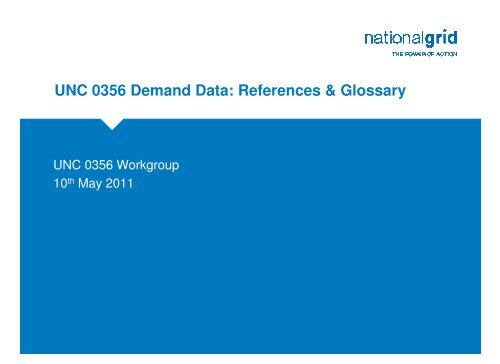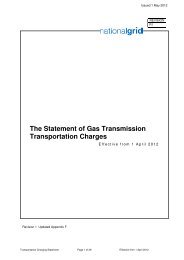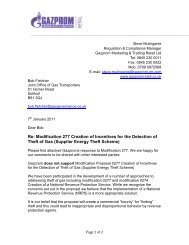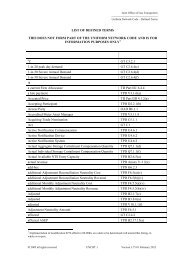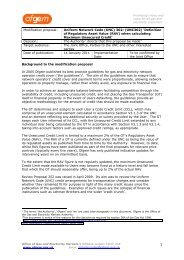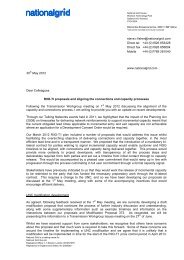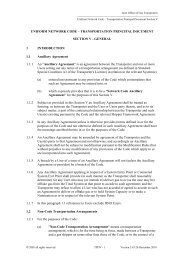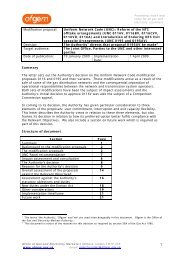1-in-20 peak day demand
1-in-20 peak day demand
1-in-20 peak day demand
Create successful ePaper yourself
Turn your PDF publications into a flip-book with our unique Google optimized e-Paper software.
UNC 0356 Demand Data: References & Glossary<br />
UNC 0356 Workgroup<br />
10 th May <strong>20</strong>11
Introduction<br />
At the 8th February <strong>20</strong>11 UNC Modification 0356<br />
Workgroup it was agreed that National Grid would<br />
provide a support<strong>in</strong>g glossary and references to clarify<br />
the terms used with<strong>in</strong> UNC Modification Proposal 0356<br />
and support<strong>in</strong>g documentation
Extract from <strong>20</strong>10 TYS<br />
3.8 Impact of Exit Reform on Peak Gas Demand<br />
Peak <strong>day</strong> gas <strong>demand</strong> forecasts assume all <strong>in</strong>terruptible contracts will be<br />
<strong>in</strong>terrupted on a <strong>peak</strong> <strong>day</strong>. From October 1 st <strong>20</strong>12 all transmission exit capacity will<br />
be firm.<br />
The undiversified firm <strong>peak</strong> <strong>demand</strong> is used where location is important. For<br />
supply/<strong>demand</strong> match<strong>in</strong>g purposes where the location is not relevant, the diversified<br />
total forecast is more appropriate. Both the diversified total and undiversified firm<br />
<strong>peak</strong> <strong>day</strong> <strong>demand</strong>s are close to the highest ever gas <strong>demand</strong>. The sold <strong>demand</strong> is<br />
the sum of all capacity sold. However each offtake is entitled to buy up to a basel<strong>in</strong>e<br />
capacity. Obligated <strong>peak</strong> <strong>day</strong> <strong>demand</strong> is the maximum of sold or basel<strong>in</strong>e at each<br />
offtake.<br />
From <strong>20</strong>12, the undiversified firm <strong>peak</strong> <strong>day</strong> will be replaced by the undiversified<br />
forecast. This is the total of National Grid’s forecasts of the highest <strong>demand</strong> at each<br />
LDZ and NTS offtake, exclud<strong>in</strong>g storage sites and IUK. This will <strong>in</strong>clude <strong>demand</strong> at<br />
new sites which do not have a basel<strong>in</strong>e capacity and have not yet bought any<br />
capacity.<br />
Three <strong>peak</strong> <strong>day</strong> <strong>demand</strong> forecasts will be produced. The diversified total will<br />
cont<strong>in</strong>ue to be the preferred figure for supply/<strong>demand</strong> analysis. Where location is<br />
important, there will be a choice of undiversified firm or obligated.
Extract from “Gas Demand<br />
Forecast<strong>in</strong>g Methodology”<br />
2.9 Diversity<br />
Diversity <strong>in</strong> the context of gas <strong>demand</strong> refers to how the <strong>demand</strong>s<br />
at different po<strong>in</strong>ts of the network are added together. Undiversified<br />
<strong>demand</strong> is derived by forecast<strong>in</strong>g <strong>peak</strong> <strong>demand</strong>s and load duration<br />
curves for each location separately, and then summ<strong>in</strong>g these<br />
calculated figures. Diversified <strong>demand</strong> is calculated by add<strong>in</strong>g<br />
together the daily <strong>demand</strong>s for all the locations first and then<br />
calculat<strong>in</strong>g <strong>peak</strong> <strong>day</strong> and load duration curves from the aggregate<br />
number. Diversified <strong>demand</strong> is the aggregate <strong>demand</strong> for a group<br />
of consumers which allows for each consumer to be us<strong>in</strong>g gas at<br />
different times. Diversity factors can be calculated as the<br />
percentage difference between undiversified and diversified<br />
forecasts. They are an output from the process not an <strong>in</strong>put.
Extract from <strong>20</strong>10 TYS<br />
Appendix One - Process Methodology<br />
A1.1.1.3 Peak Day Demand Modell<strong>in</strong>g<br />
Once the annual <strong>demand</strong> forecasts and daily <strong>demand</strong>/weather<br />
models have been developed, a simulation methodology is<br />
employed, us<strong>in</strong>g historical weather data for each LDZ, to determ<strong>in</strong>e<br />
the <strong>peak</strong> <strong>day</strong> (<strong>in</strong> accordance with statutory/Licence obligations) and<br />
severe w<strong>in</strong>ter <strong>demand</strong> estimates. Where possible, the <strong>peak</strong> <strong>day</strong><br />
<strong>demand</strong> of the NTS supplied loads, such as the power stations, are<br />
based on the contractual arrangements. Export <strong>demand</strong>s are<br />
treated slightly differently; the Belgian Interconnector is assumed<br />
not to be export<strong>in</strong>g at times of <strong>peak</strong> <strong>demand</strong>, due to the high price<br />
of British gas, and Irish <strong>demand</strong> is derived from the market sector<br />
based approach mentioned above. For the post exit [reform]<br />
undiversified <strong>peak</strong> <strong>day</strong> there is an obligated <strong>peak</strong> <strong>day</strong> based on<br />
contractual obligations and a forecast <strong>peak</strong> <strong>day</strong> which reflects<br />
actual consumption of the NTS supplied loads.
UNC – General Terms Section C<br />
2.6.4 For the purposes of the Code, <strong>in</strong> relation to the Total System,<br />
any part of the Total System, a System or any part of a System,<br />
and <strong>in</strong> respect of any Gas Year:<br />
(a) "<strong>peak</strong> <strong>day</strong> <strong>demand</strong>" is the highest <strong>demand</strong> for gas on any<br />
Day <strong>in</strong> that year;<br />
(c) "1-<strong>in</strong>-<strong>20</strong> <strong>peak</strong> <strong>day</strong> <strong>demand</strong>" is the <strong>peak</strong> <strong>day</strong> <strong>demand</strong> that,<br />
<strong>in</strong> a long series of w<strong>in</strong>ters, with connected load be<strong>in</strong>g held at<br />
the levels appropriate to the w<strong>in</strong>ter <strong>in</strong> question, would be<br />
exceeded <strong>in</strong> one out of <strong>20</strong> w<strong>in</strong>ters, each w<strong>in</strong>ter be<strong>in</strong>g counted<br />
only once;<br />
2.6.7 A reference <strong>in</strong> the Code <strong>in</strong> relation to any Gas Year to "Total<br />
System 1-<strong>in</strong>-<strong>20</strong> <strong>peak</strong> <strong>day</strong> <strong>demand</strong>" is the 1-<strong>in</strong>-<strong>20</strong> <strong>peak</strong> <strong>day</strong> <strong>demand</strong><br />
for the Total System established for the Gas Year pursuant to TPD<br />
Section O and set out <strong>in</strong> National Grid NTS's Ten Year Statement.
UNC TPD Section O<br />
Publication of Forecast Data<br />
The follow<strong>in</strong>g section of the UNC allows for the publication of charg<strong>in</strong>g related data. This would need to be modified to cover additional<br />
years if an alternative proposal, us<strong>in</strong>g solely forecast data, was raised. The follow<strong>in</strong>g bold text was <strong>in</strong>troduced via UNC 0134V <strong>in</strong>to the<br />
UNC to overcome confidentiality issues (forecast data relat<strong>in</strong>g to a s<strong>in</strong>gle shipper).<br />
4.1.2 The Ten Year Statement will typically <strong>in</strong>clude:<br />
(a) details for year - 1 of actual <strong>peak</strong> <strong>day</strong> <strong>demand</strong>:<br />
(i) for the Total System; and<br />
(ii) for System Exit Po<strong>in</strong>ts (other than Unmetered Connected System Exit Po<strong>in</strong>ts) <strong>in</strong> accordance with paragraph<br />
4.1.3;<br />
(b) estimates:<br />
(i) for each of years 0 to 9 (or for certa<strong>in</strong> of such years), of Total System 1-<strong>in</strong>-<strong>20</strong> <strong>peak</strong> <strong>day</strong> <strong>demand</strong> and the Total System seasonal<br />
normal annual <strong>demand</strong>, upon each of the <strong>demand</strong> growth assumptions under paragraph (e) below; and<br />
(ii) for each of years 0 to 2, of 1-<strong>in</strong>-<strong>20</strong> <strong>peak</strong> <strong>day</strong> <strong>demand</strong> <strong>in</strong> accordance with paragraph 4.1.3;<br />
(c) estimates for each of years 0 to 9 (or for certa<strong>in</strong> of such years) of maximum daily supply for the Total System, by System<br />
Entry Po<strong>in</strong>t, and the assumptions (<strong>in</strong> accordance with paragraph 2.2.1) on which such estimates were made;<br />
(d) an estimate for year 1 of the amounts by which maximum daily supply falls short of Total System 1-<strong>in</strong>-<strong>20</strong> <strong>peak</strong> <strong>day</strong> <strong>demand</strong>;<br />
(e) different assumptions as to overall growth <strong>in</strong> <strong>demand</strong> for gas <strong>in</strong> years 0 to 9 or certa<strong>in</strong> of such years;<br />
(f) the pr<strong>in</strong>cipal economic and other assumptions made by National Grid NTS <strong>in</strong> prepar<strong>in</strong>g such estimates; and<br />
(g) a reference date for the mak<strong>in</strong>g of estimations of <strong>demand</strong>.<br />
Notwithstand<strong>in</strong>g the forego<strong>in</strong>g, National Grid NTS may elect to publish all or part of the <strong>in</strong>formation set out above either<br />
with<strong>in</strong> the Ten Year Statement or separately (but at the same time as publish<strong>in</strong>g the Ten Year Statement). Where National Grid<br />
NTS elects to publish such <strong>in</strong>formation separately from the Ten Year Statement, National Grid NTS shall not be required to<br />
update such <strong>in</strong>formation at any time after publication.<br />
4.1.3 The details or estimates under paragraphs 4.1.2(a)(ii) and 4.1.2(b)(ii) will be given <strong>in</strong> respect of each NTS Exit Po<strong>in</strong>t on an<br />
<strong>in</strong>dividual basis (but not for Storage Connection Po<strong>in</strong>ts).


